|
Armstrong Siddeley
|
1902
- 1967 |
Country: |
 |
|
The Clipper Pneumatic Tyre Company
John Davenport Siddeley was one of the early advocates of the pneumatic tire for motor vehicles. By the turn of the century he had become managing director of the Clipper Pneumatic Tyre Company, of Aston Cross, Birmingham, whose products were claimed to be 'Best for all forms of Automobile Cycles or Carriages.' To prove their worth, Siddeley had a set of his tires fitted to a Parisian Daimler, which competed in the 1900 Thousand Miles' Trial: and apart from a handful of punctures caused by the appalling road surfaces en route, the tires proved quite reliable.
Siddeley himself had taken part in the trial at the tiller of his 6hp Daimler (with solid tires), and had gained joint second prize in the class for cars selling between UK£300-UK£500. Within a couple of years, however, Siddeley had become convinced that there was a brighter future in the manufacture and sale of motor cars than tires, and began, initially, to import Peugeot cars from France, then, backed by Lionel de Rothschild, approached the mighty Vickers, Sons & Maxim armaments group, which was already producing Wolseley cars, to see whether they would be prepared to build cars to Siddeley's design under licence.
Siddeley Autocar
The Vickers brothers were becoming increasingly dubious of the merits of the horizontal-engined vehicles which Herbert Austin was producing for them, and decided that production of vertical-engined cars of the type proposed by Siddeley could be insurance for the future. So the Siddeley Autocar Company was established in 1902, though it seems likely that the first cars to bear the Siddeley name were merely re-radiatored Peugeots.
Then came a 6hp light car, which seemed to go against all Siddeley's design philosophy with its horizontal engine. Apart from its square-cut radiator and bonnet, this was identical to the contemporary small Wolseley, and was built in Wolseley's Crayford, Kent, factory. The 6hp Siddeley was, it seems, distinctive enough to stand on its own merits, winning a first class award and gold medal in the 1904 ACGBI Small Car Trials at Hereford for 'general excellence of design, construction and workmanship, and for hill-climbing": but the larger-engined Siddeleys, though obviously Peugeot-inspired, were entirely different from anything that Wolseley had so far manufactured.
The Siddeley 12 and 18hp had vertical engines, channel steel chassis and chain final drive. An advanced feature was the use of overhead inlet valves, with pushrod operation 'after the manner of this year's De Dietrichs and last year's Mercedes ... fulcrummed in a small block, which can be raised or lowered at will by means of a small lever on the steering wheel': varying the lift of the inlet valves in this way gave a somewhat empiric form of throttle control by altering the amount of petrol/air mixrure drawn into the cylinders.
The 12hp Siddeley had a two-cylinder pair-cast engine, one of the earliest cars being supplied for War Office use, and another example managed 998 marks out of a possible 1000 for a non-stop run from Glasgow to London in 1904; in early 1905, John Siddeley drove a 12hp on a 5000-mile observed reliability run in a snowstorm. The 16hp, with a four-cylinder engine, was claimed to be 'perfectly silent-very powerful', and was capable of recording over 20 miles per gallon under ACGBI observation.
Lionel de Rothschild
At this period, the Siddeley Autocar Company were also agents for Birmingham-built Mulliner coachwork. Early in 1905, Siddeley built a monstrous 100hp racing car to the order of Lionel de Rothschild, which was entered for the Gordon Bennett Eliminating Trials in the Isle of Man, to be driven by Sidney Girling. It followed the design of the company's touring cars, with inlet valves operated by pushrods and rockers, and had dual ignition by magneto and coil systems. Engine and transmission were three-point-suspended in the frame, there was a multi-plate clutch, and the three-speed gearbox drove the rear axle through side chains.
'The new Siddeley is said to have shown an extraordinary turn of speed during its trial runs,' commented Country Life: but though the car proved as fast as any of its rivals in the eliminating trials, it failed to stay the distance.' Four days before the eliminating trials, on 26 May, 1905, a meeting of the board of the Wolseley Tool & Motor Car Company, Douglas and Albert Vickers announced that they were forming a committee of investigation to look into the possibility of Wolseley absorbing the Siddeley Autocar Company: not long after, the takeover took place, and Siddeley became manager of Wolseley, a move which soon resulted in the resignation of Austin, who left in a huff to set up on his own.
Wolseley-Siddeleys, Siddeley-Wolseleys or just plain Siddeleys
Siddeley lost no time in impressing his personality on the company, and the cars were known indifferently as Wolseley-Siddeleys, Siddeley-Wolseleys or just plain Siddeleys: new models designed by Charles Rimmington appeared. In the 1906 Coupe du Matin, a 6000 mile reliability trial which encompassed both the Alps and the Pyrenees, two 32hp Siddeleys were the only British competitors, and were successful in the Large Car class, which necessitated a total weight of 47cwt and an average speed of 28.13 mph. Commented Motoring Illustrated: 'Le Matin, under whose auspices this trial took place, has nothing but praise for the behaviour of the two British cars, and states that their performance has been quite a revelation to French makers of what a British-built car is capable of doing.'
Shortly afterwards an 18 hp Siddeley won a gold medal in quite a different type of competition, the Town Carriage contest held in London. The award was made for 'the all-round usefulness ... general design (chassis and body) and all the numerous details of construction and accessories which are desirable in forming the most comfortable, smooth-running and generally satisfactory town carriage.' The spring of 1907 saw a 40hp Siddeley undertaking a 10,000 mile reliability trial, and meeting snow as deep as the wheels in the Spittal of Glenshee, where 'the official observer decided further progress to be undesirable, and took the car back to Dundee'.
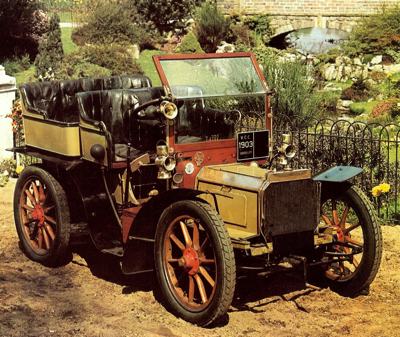 1903 Siddeley, which was really a re-badged Peugeot.
1903 Siddeley, which was really a re-badged Peugeot.
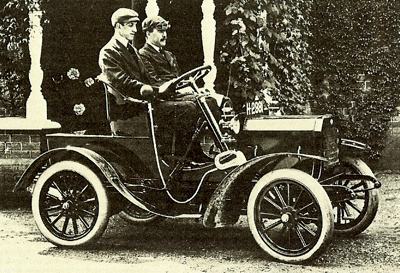 1904 Siddeley 6hp, which was built in Wolseley's factory.
1904 Siddeley 6hp, which was built in Wolseley's factory.
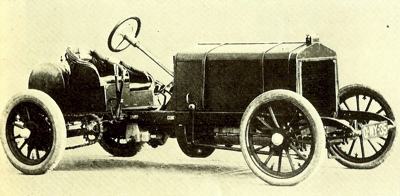 1905 100hp Racing Siddeley. Although fast, it failed to finish in the Gordon Bennett Eliminating Trials. This was one of the last cars made before the merger with Wolseley.
1905 100hp Racing Siddeley. Although fast, it failed to finish in the Gordon Bennett Eliminating Trials. This was one of the last cars made before the merger with Wolseley.
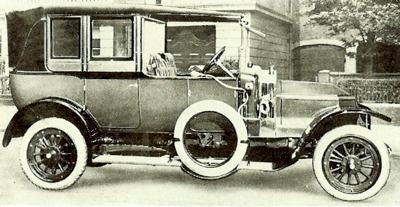 1912 Siddeley-Deasy.
1912 Siddeley-Deasy.
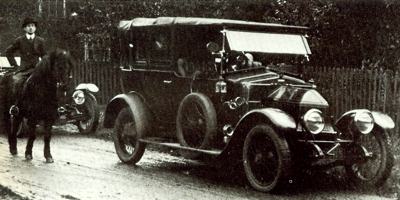 1914 Siddeley-Deasy Tourer.
1914 Siddeley-Deasy Tourer.
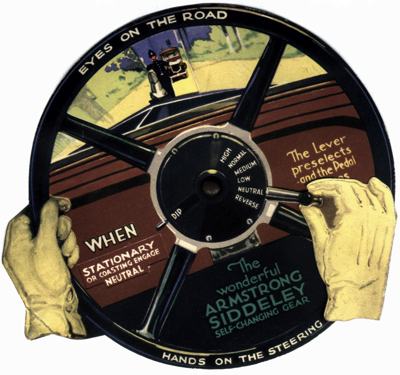 1928 Armstrong Siddeley Preselector transmission advertisement.
1928 Armstrong Siddeley Preselector transmission advertisement.
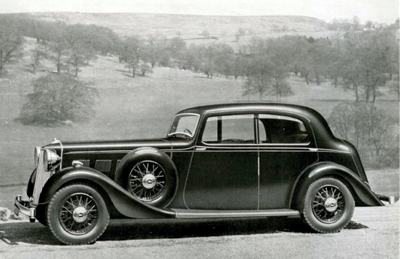 1937 Armstrong Siddeley Atalanta 25hp.
1937 Armstrong Siddeley Atalanta 25hp. |
Elastes Tires
A notable feature of the car was the fact that the tires were filled with Elastes, a noxious mixture which was supposed to eliminate punctures. However, far from eliminating punctures, the Elastes caused them in profusion. Explained the Wolseley company: 'It appears that the Elastes fillings, which were used in conjunction with Michelin outer covers throughout the trial, are made on tires fitted to rims, and the rims used for this purpose differ in regard to the shape of the bead from those employed on the car. In consequence of this, the Elastes, which is naturally less adaptable than air, was altered in form when fitted to these new rims, causing a sawing action to arise at the head of the bead and cutting through the sides of the tire .
The greater number of covers used on the trial were damaged from this cause, and the result cannot, therefore, be in justice taken as reflecting on the durability of the Michelin tire in normal use. 'In regard to the time spent in adjustments to the car itself, the makes point out that, taking the cost of the work on the ordinary repair shop basis of 2S 6d per hour, the result shows a total of 29S for the 10,000 miles, while the new parts required to put the car in perfect repair were new bushes and pins to the front spring shackles at a cost of IS rod.'
In that year's Coppa Florio (and other Italian events) Wolseley cars were in evidence: these were Wolseley-Siddeleys built under licence in Milan by the Fabbrica Italiana Automobili Legnanese, who went out of business in 1908. At this period, Wolseley was not a particularly successful company-it was only the Vickers millions which kept it from foundering irrevocably. A profit had only been made in two years since the company's formation, 1902 and 1903, since when the annual losses had been mounting up. The pattern continued at first under Siddeley's direction, with the annual loss mounting to £60,000, then falling back to £36,000.
Captain H. H. P. Deasy and Martini Cars
In 1909 Siddeley resigned, and the management was taken over by E. Hopwood. Siddeley now joined Captain H. H. P. Deasy, formerly well-known as the importer of
Martini cars, who had been a manufacturer in his own right since the end of 1906 building a 'moderate-priced car on up-to-date lines' designed by E. W. Lewis, formerly with Rover. The original Deasy had been a 4
½-liter model of neat appearance, distinguished by enormous brake drums, an adjustable steering column and a Rover-style camshaft brake, which slowed the engine by cutting off the lift of the valves, turning the cylinders in effect into compressors.
The Car That Holds The Road
But by 1909, giantism had set in: the range was now headed by two huge four-cylinder models, the 8621cc 35hp and the 11,974cc 45hp. Siddeley changed all that immediately, and reshaped the company's offerings to more manageable - and saleable - proportions, with the announcement for 1910 of the new 'JDS' model, a 4084cc four-cylinder with a dashboard radiator and the power unit housed beneath a 'coffin-nosed' bonnet. Final drive was by Lanchester worm gearing, and rear suspension was on the Lanchester pattern, too, with cantilever springs and parallel-motion radius links to locate the back axle: this feature gave the JDS Type Deasy its slogan - 'The car that holds the road.'
The Siddeley-Deasy Motor Manufacturing Company
There was soon a small JDS, too, in the shape of the 14/20hp of 2654cc: 'Simply delightful,' gushed an enthusiastic owner. Oddly enough, though Siddeley was long gone from them, Wolseley were still advertising their cars as Wolseley-Siddeleys at the end of 1910 (though they set the Siddeley name in smaller type to make the position at least partially clear). In 1912, the Deasy Motor Car Company became the Siddeley-Deasy Motor Manufacturing Company, thus setting the seal on Siddeley's influence over their policies: co-incident with the changeover came two new models with Silent Knight sleeve-valve engines, the 18/24 of 3308cc and the 24/30 of identical cylinder dimensions but six cylinders, which brought the swept volume to 4962cc.
Merger with Armstrong-Whitworth
Alongside these were offered two poppet-valve models, the 12hp of 1944cc and the 18/24 of 3308cc (with identical bore and stroke to its sleeve-valve sister). A six-cylinder model was announced for 1914: this was the 30/36hp of 4962cc, another engine designed with identical cylinder measurements to the sleeve-valve model. Fortunately, this confusion of induction gear was brought to an abrupt halt by the onset of the European hostilities, and not given a chance to recur after the Armistice, when Siddeley-Deasy merged with the Sir W. G. Armstrong, Whitworth Company. Armstrong-Whitworth were a famous Tyneside engineering and shipbuilding concern who had entered the car industry in 1904, building the Wilson-Pilcher, which had a flat-four engine and pre-selective four-speed transmission.
Armstrong Siddeley Motors
From 1906 their Scotswood-on-Tyne car factory became increasingly concerned with the new Armstrong-Whitworth car, a handsome machine on Mercedes lines. In 1913 the Scotswood factory was enlarged, and a new bodybuilding and repair works opened at Openshaw, Manchester. But with the merger, all production was transferred to the Siddeley-Deasy factory at Coventry: after the fusion of the interests of the two companies, the new firm was known as Armstrong Siddeley Motors. The first Armstrong Siddeley car to be produced was a six-cylinder 30hp of 5 liters and ponderous appearance.
Its heavy Vee-radiator (surmounted by a Sphinx mascot) and disc wheels were massive rather than elegant, and it appeared to have been styled on the lines of an Armstrong-Whitworth Dreadnought. But it was intended for a clientele who prized comfort and reliability above all else: and in a 1921 advertisement the Armstrong Siddeley company summed up the philosophy behind the car. 'From the time of its introduction in 1919 our settled policy has been to make the Armstrong Siddeley 6 cylinder car the best car-both for performance and economy-which can be produced and to sell it at the lowest possible price. This policy still holds. 'In the period which has elapsed, the Armstrong Siddeley has proved itself a fine motor carriage of perfect comfort, costing less to buy than any other car of like capacity and achievement, and less to run. Its leading features are reliability, comfort, power, silence, ease of handling, distinguished appearance, and economy in operation.
'One result of the success of the 30hp Armstrong Siddeley has been a strongly expressed desire from another large section of the public for a car of like advantages which shall cost even less to buy and run. 'In response to that demand we have decided - while maintaining the 30hp Armstrong Siddeley as our leading product - to introduce a model of less power and seating capacity, but, except in the matter of dimensions and weight, of identical design and also of the same high quality. This is to be known as the 18hp Armstrong Siddeley 6 cylinder car.' Prices of the 30hp ranged from UK£775 for the chassis to UK£1250 for the laundaulette; the new 18hp model cost £575 in chassis form, £975 for the landaulette.
Early in 1922, a contemporary motoring journal carried out a comparison test between the two models, an open tourer on the 18hp chassis and a magnificently equipped 30hp saloon owned by J. Davenport Siddeley CBE himself. Commenting on the silence of the overhead valve gear and the transmission, the tester wrote: 'The first outstanding impression is the extreme ease of the pedal and hand controls, the freedom of action and the general docility of the engine, all of which characteristics engender a feeling of confidence, not to say repose, in gliding along the road ... 33mph would appear to be the most comfortable speed of the 18hp model, at which rate it swoops smoothly over hill and dale, and little affected by the state of the road surface ... the larger car glided in silence over pot-holes that would cause a dither in every part of a light and frail vehicle ... the steering is light and of the single-finger order ... one fits a car such as this with the extreme ease and comfort which suggests that the bodywork was designed to suit individual anatomical standards ... of rattles and jingles there were none, even over deserted roads that permitted with safety a high average-just one long silent swoop, using one lever only, and that the accelerator, to govern speed-no strain, unlimited reserve power, and a feeling that it could be maintained ad libitum.'
The Stoneleigh Motors Light Car
Against this background of ostentation, Armstrong Siddeley's next venture seemed uncharacteric, as their subsidiary, Stoneleigh Motors, now offered a curious light car, with a single, central driver's seat in front, and two passengers seats behind; it was powered by a 1 liter Vee-twin engine claimed to be constructed from World War 1 radial aero-engine cylinders. The car was not a success, and production ceased in 1924. In the summer of 1922, an 18hp Armstrong Siddeley tourer covered 10,010 miles in 23 days, recording 24·64mpg and using six pints of oil: it travelled 450 miles every day (but rested each Sabbath), yet spent less than two hours in the entire period being serviced or repaired, and retained the same four tires throughout the trial.
Sir Alan Cobham and 'The Car of Aircraft Quality'
In 1923 a new small Armstrong Siddeley appeared - this was the 14hp, a 2-liter four-cylinder model which had a flat radiator instead of the marque's distinctive vee-cooler. It was a refined and silent car, and there was a rare sporting version with vee-screen and cruiser tail, which was apparently 'sporting' only in appearance, with a maximum speed of little more than 45 mph. About this time, too, Armstrong Siddeley aero engines were establishing an enviable reputation - Sir Alan Cobham used an Armstrong Siddeley Jaguar radial for his flight from London to Capetown and back - and it was not long afterwards that the slogan 'The Car of Aircraft Quality' was adopted.
The 1924 season saw the adoption of four-wheel brakes on the larger Armstrong Siddeley models: the range continued virtually unchanged until the end of 1927, when centralised chassis lubrication and automatic ignition advance and retard became standard features of all models. And on 1st November, 1927, deliveries of a new low-priced 15hp six-cylinder Armstrong Siddeley began. A year later, it was joined by an even smaller six, the 1236cc 12hp, which a former owner characterised as 'sluggish beyond belief'. Also in 1929 came the option on all models of the Wilson pre-selective gearbox, which was really a harking back to one of the roots of the company, the veteran Wilson-Pilcher. This type of epicyclic transmission was standardised on Armstrong Siddeleys in 1933.
The Motor Rally Mystery, by John Rhode
The 'aircraft quality' slogan was really taken seriously: at the company's Parkside works, aero-engines and cars were assembled in parallel, and the same Aeronautical Inspection Department standards were applied to both: thus a 1.2-liter 12 was finished to the same strict standards as a 47.5-liter 14-cylinder Leopard radial aero-engine. For 1931, the stroke of the 12 was lengthened, bringing the swept volume up to 1434cc, while the 15hp was now available in a choice of wheelbase lengths, with a general tidying-up of chassis design. The Short 15 had a three-speed transmission, the long 15 four speeds. This was the period when luxuriously equipped 'Arrnsrrong Siddeleys were doing well in events like the RAC Rally and the Monte Carlo Rally: the marque was even featured in a rare murder novel, The Motor Rally Mystery, by John Rhode, based on the author's experiences in the 1931 RAC Rally.
The Siddeley Special
At the 1932 London Motor Show the chassis of a magnificent new model was shown: this was the Siddeley Special, which had a s-liter engine cast largely from Hiduminium light alloy-crankcase, block, cylinder head and sump were all of this material, though it seems likely that the same pattern of crankshaft and connecting rod which had served Armstrong Siddeley faithfully since 1919 was used, for the cylinder dimensions were identical with the old 30hp model. This power unit, which gave a 6-93mph performance in top gear, was mounted in a massively-built double-dropped chassis; standard wheelbase was 11ft, but a 12ft wheelbase was available for closed coachwork. Chassis price was UK£650, to which tourer coachwork added another UK£300.
The Daughters of Gentlemen
The car did not reach production until the end of 1933, by which time a new sporting variant of the 12hp, which had a vee-radiator instead of the models characteristic flat front, was also available. It had attractive close-coupled coupe coachwork which, claimed the newly knighted Sir John Siddeley was designed for 'the daughters of gentlemen'. At the 1934 Motor Show, two more new Armstrong Siddeleys were revealed - these were the Seventeen and Seventeen Sports, both with a 2394cc six-cylinder power unit, but having different wheelbase lengths and suspension arrangements.
Armstrong Siddeley sales were strong with annual output generally around the thousand mark and it was observed that there were now 7000 employees at the Parkside works where there had been only 500 25 years earlier, in the days of the JDS-Deasy. The Plus Twelve was a new model for the 1936 season; this had a 1670 cc power unit 'to provide a greater reserve of power for arduous conditions'. Another new Armstrong Siddeley was launched at the 1936 Motor Show, designed to compete in export markets and rated at 20/25hp. Its robust 3666cc engine - a six-cylinder - consumed petrol at 17-18 miles per gallon, and was capable of over 80 mph performance.
Lord Kenilworth
In 1937, Sir John Davenport Siddeley was elevated to the peerage, as Lord Kenilworth; there was some rationalisation among the car range that year, but the Armstrong Siddeley line-up remained virtually unchanged in basics, until 1939, in which year the Siddeley Special was dropped after some 400 had been produced and two new medium-powered models were announced. The new models were the 1991cc 16/6 and the 2783cc 20. Production was soon resumed after the war - in which Armstrong Siddeley built around 4000 Cheetah radial aero-engines for Ansons and Oxford training reconnaissance aircraft, as well as tank transmissions and precision equipment for the Navy - doubtless due to the old parallel production system.
Using the 1939 16/6 power unit, the company brought out Britain's first post-war models, named after some of the famous warplanes produced by the Hawker Siddeley Group, of which the company was a member. These were initially the Lancaster four-door saloon, the Typhoon two-door sports saloon and the Hurricane drop-head coupe: their 'modem smooth-flowing lines' attracted much favourable comment, as did the adoption of torsion-bar independent front suspension and the adoption of heating/demisting equipment as standard. In 1948 came the Whitley, with a 2309cc engine, which power unit was standardised throughout the range in 1950.
The Armstrong Siddeley Sapphire and Star Sapphire
At the 1952 London Motor Show, the Sapphire luxury model was introduced, with a 3·4-liter engine and, for a while at least, the option of manual, pre-selective or automatic transmission. In 1958 came the Star Sapphire, with a 4-liter engine, disc brakes and power steering, with separate heating for the passenger compartment. It succeeded two unsuccessful models, the 234 and 236, the former with a 2.3-liter engine having only four cylinders, the latter using the old long-stroke six-cylinder power unit. Their bland lines and poor sales ensured their early demise, after being on sale only from 1956-1958.
The Star Sapphire was a very good car, offered only with automatic transmission: but in 1960, as a result of the merger between Hawker-Siddeley and the Bristol Aeroplane Company, the decision was made to stop car production. That summer saw the very last Armstrong Siddeley slowly drive out of the Parkside factory into the sun - and motoring history.
